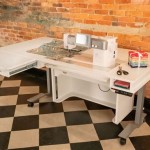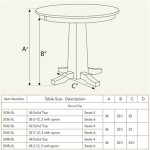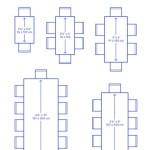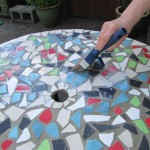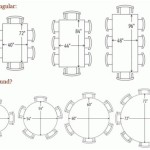Half Moon Table Dimensions: A Comprehensive Guide
Half moon tables, also known as demilune tables, are versatile pieces of furniture that offer a blend of functionality and aesthetic appeal. Their distinctive shape, resembling a half circle, makes them ideal for various applications within the home, from serving as elegant accent pieces in hallways to providing compact surfaces in smaller living spaces. Understanding the typical dimensions of half moon tables is crucial for selecting the right piece that complements the intended room and fulfills specific functional needs. This article provides a detailed exploration of half moon table dimensions, considering factors such as height, width, depth, and variations based on style and purpose.
Standard Dimensions of Half Moon Tables
While customization and design variations exist, certain standard dimensions are commonly observed in half moon table manufacturing. These standard sizes provide a practical framework for interior designers and furniture buyers to navigate the market effectively. The dimensions are typically described in terms of height, width (diameter of the full circle), and depth (distance from the straight edge to the farthest point on the curved edge). Understanding these metrics is essential for ensuring that the table fits appropriately in the designated space and serves its intended purpose.
Height: The height of a half moon table generally ranges from 28 to 36 inches. This range accommodates various uses, from serving as a console table near an entryway to functioning as a side table in a living room. A standard height of 30 inches is particularly common, as it aligns with the height of many other furniture pieces, facilitating a cohesive look within a room. However, specific applications may necessitate different heights. For example, a half moon table intended for use as a small writing desk might benefit from a height closer to 30 inches to provide comfortable legroom.
Width (Diameter): The width, which represents the diameter of the full circle the half moon table would complete, typically ranges from 30 to 48 inches. This measurement significantly impacts the table's visual presence and functional surface area. A smaller width, around 30 inches, is suitable for tight spaces, such as narrow hallways or entryways, where minimizing obstruction is paramount. Conversely, a larger width, approaching 48 inches, provides a more substantial surface for displaying decorative items, holding lamps, or serving refreshments.
Depth: The depth of a half moon table typically ranges from 15 to 24 inches. This measurement is critical for determining the table's footprint and how it interacts with the surrounding space. A shallower depth, around 15 inches, is ideal for areas where space is limited, preventing the table from protruding excessively into the room. A deeper depth, approaching 24 inches, offers a larger surface area for placement of items and contributes to a more visually substantial presence. The depth should be carefully considered in relation to the width to ensure that the table maintains a balanced and aesthetically pleasing proportion.
It is important to note that these are general guidelines, and variations exist depending on the style and intended use of the half moon table. Antique or reproduction pieces, for example, may deviate slightly from these standard dimensions due to historical design conventions or manufacturing processes. Similarly, custom-made half moon tables can be tailored to specific dimensions to meet the unique requirements of a particular space or individual preference.
Dimensional Variations Based on Table Style
The style of a half moon table significantly influences its dimensions. Different design aesthetics often incorporate specific proportions and features that alter the standard measurements. Understanding these style-related variations is essential for selecting a half moon table that not only fits the intended space but also complements the overall design scheme of the room.
Console Tables: Half moon console tables are commonly placed against walls in hallways, entryways, or living rooms. These tables typically feature a taller height, ranging from 32 to 36 inches, to provide an elevated surface for displaying decorative items or holding lamps. The width can vary depending on the available space, but a common range is 36 to 48 inches. The depth tends to be relatively shallow, typically between 16 and 20 inches, to minimize obstruction in hallways or entryways. The legs of console tables are often more ornate and contribute to the overall decorative appeal.
Entryway Tables: Similar to console tables, half moon entryway tables are designed to be placed in entryways or foyers. Their dimensions are generally comparable to console tables, with a height ranging from 30 to 34 inches and a width between 32 and 40 inches. However, entryway tables may incorporate additional features, such as drawers or shelves, for storing keys, mail, or other items. These features can slightly increase the overall depth of the table, typically to around 18 to 22 inches.
Side Tables: Half moon side tables are designed to be placed next to sofas, chairs, or beds. Their height is typically shorter than console or entryway tables, ranging from 24 to 28 inches, to align with the height of the adjacent furniture. The width is usually smaller, between 24 and 36 inches, to provide a compact surface for holding drinks, books, or lamps. The depth is similarly reduced, typically between 12 and 18 inches, to minimize the table's footprint in the room. These tables are often more minimalist in design, focusing on functionality and blending seamlessly with the surrounding furniture.
Dining Tables: Although less common, half moon tables can also be used as small dining tables, particularly in compact spaces. These tables typically have a height of around 30 inches, consistent with standard dining table height. The width and depth will vary significantly depending on the intended seating capacity. A half moon dining table designed for two people might have a width of 36 to 42 inches and a depth of 24 to 30 inches. These tables often feature a sturdier construction to support the weight of dishes and other dining items.
Factors Influencing Dimension Selection
Selecting the appropriate dimensions for a half moon table involves considering several factors beyond the standard measurements and style variations. These factors include the intended function of the table, the available space, the existing furniture in the room, and the desired aesthetic impact. A careful assessment of these factors is crucial for making an informed decision and ensuring that the table effectively serves its purpose while complementing the overall design of the space.
Intended Function: The primary function of the half moon table is a key determinant of its ideal dimensions. A table intended for displaying decorative items, such as vases or sculptures, might benefit from a larger width and depth to provide ample surface area. Conversely, a table intended for holding a lamp or serving as a bedside table might require a smaller footprint to maximize space efficiency. If the table is intended for storage, the presence and size of drawers or shelves will influence the overall dimensions.
Available Space: The amount of available space is a critical constraint in selecting the appropriate dimensions. In narrow hallways or entryways, minimizing the depth of the table is paramount to prevent obstruction and maintain a clear passage. In larger rooms, a larger width and depth may be preferred to create a more substantial visual presence. It is essential to measure the available space accurately and consider the surrounding traffic flow to ensure that the chosen dimensions are practical and aesthetically pleasing.
Existing Furniture: The dimensions of existing furniture in the room should also be considered when selecting a half moon table. The height of the table should be proportional to the height of adjacent sofas, chairs, or beds to create a cohesive visual flow. The style and scale of existing furniture should also be taken into account to ensure that the half moon table complements the overall design scheme. For example, a minimalist half moon table might be more suitable for a modern interior, while a more ornate table might be appropriate for a traditional setting.
Aesthetic Impact: The desired aesthetic impact of the half moon table should also influence the selection of dimensions. A larger table with a more dramatic design can serve as a focal point in the room, while a smaller, more understated table can blend seamlessly with the surrounding décor. The choice of materials and finishes can also influence the perceived size and visual weight of the table. A dark-colored table, for example, might appear more substantial than a light-colored table of the same dimensions.
In summary, understanding the standard dimensions of half moon tables, considering style-related variations, and carefully assessing the intended function, available space, existing furniture, and desired aesthetic impact are crucial for selecting the right piece. By taking these factors into account, furniture buyers and interior designers can ensure that the chosen half moon table effectively serves its purpose while enhancing the overall design of the space.

Half Round Table On Call Event Als

Half Moon Round Wedding Tables Hmt340 Foshan Cargo Furniture

Aalto Artek Half Round Table Milia

Half Circle Classroom Table

Luxenhome Rustic Wood Half Moon Table Whif771 The Home Depot

48 Half Moon Table For In Los Angeles Wedding Tables

Monarch Specialties 36 In White Standard Half Moon Console Table With Storage I 2451 The Home Depot

Naples Glass Semi Circle Console Table

Half Moon Table Round Classroom Community Playthings

Little Fingers Half Moon Plastic Activity Table Set With 4 Chairs Intra Kids School Supplies

